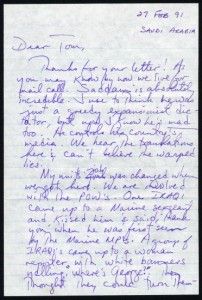Military Mail Stories at the Postal Museum
A new exhibition covers the history of mail in the military
/https://tf-cmsv2-smithsonianmag-media.s3.amazonaws.com/filer/20111216020003WWI-Letter-Writing-Small.jpg)
With the war in Iraq officially declared over yesterday, it seemed appropriate to head to the National Postal Museum to reflect upon the experiences of servicemen who are stationed abroad. “Mail Call: A History of America’s Military Mail,” an exhibition that opened last month, tells the stories of individual soldiers through their mail, and traces the history of mail delivery for the military from the Revolutionary War through today.
“Mail sustains the spirits, both on the home front and for the people who are on the front line,” says Lynn Heidelbaugh, curator at the museum. “We wanted to show visitors how it keeps up this connection, and keeps up this sense of community.”
The exhibition features a number of letters that serve as windows on the personal lives on soldiers stationed abroad. One was sent by John H. Zimmer, a serviceman stationed in France during World War I, to his younger sister Frances. “Just a few lines to let you know that I received your letter today and was very glad to hear from you,” he wrote. “I haven’t been getting many letters for several weeks until today when I received seven. But gee, I was awful glad to get them.”
The show also covers the evolution of the military mail system across the full sweep of its history, starting with the country’s founding. “Mail was really expensive during the Revolutionary War—most people were writing just for business purposes, because postage was too much to use otherwise,” says Heidelbaugh. Over time, as prices came down, mail became the sole source of communication between distant points. With the Spanish-American War and World War I—the first U.S. global wars—the challenges confronting the Postal Service grew dramatically.

Mail officials responded with a number of innovations, sending postal employees around the world to carry out the mission. During World War II, the Postal Service promoted the sending of “Victory Mail,” which were letters written on a standardized stationary and projected onto microfilm to save shipping weight. The reels of microfilm were sent to processing centers abroad, and letters were reproduced on quarter size pieces of paper to be delivered to recipients.
Audio reels were sometimes used during the Vietnam War for the same reason. ”We have one recording from a soldier stationed in Vietnam,” Heidelbaugh says. “He actually talks about what mail has meant to him, and his outlook in the future—everything you expect in a letter from wartime.”
When all of the varied locations where mail is delivered during times of war is considered, the strategic operation is mind-boggling. “The Postal Service tries to make sure that all services are available to everyone,” Heidelbaugh says, “whether they’re in a tent somewhere or in a submarine.” On display is an actual door from the post office that was aboard the U.S.S. Thomas S. Gates, a Navy cruiser, as well as a camouflaged, waterproof mail bag that was used for aerial mail drops to troops in the jungles of Vietnam.
Other items in the exhibition remind visitors of the grim truth of war. Many letters bring news of horrific tragedy. One is a Certified Mail stamp that was salvaged from the Naval base at Pearl Harbor, Hawaii. The date on the stamp is still December 6, 1941—the day before the infamous attacks on the base that claimed the lives of thousands.
The other is a letter addressed to a Union soldier’s wife at the height of the Civil War. “One of the pieces I find most touching—and sadly, the most typical kind of letter—is this condolence letter,” says Heidelbaugh. “It’s from a commanding officer, and he’s had to write to a widow, and confirm that her husband has died in a POW camp.”
Appropriately, the show concludes with a package sent from the recent conflict in Iraq. ”We chose this because it’s representative of contemporary mail,” says Heidelbaugh. The package was sent by Chief Warrant Officer Peter Paone to his son Tom, back in Pennsylvania, and carried souvenirs from his time abroad. “A lot of people ask, ‘with so many more options for communication now, what are people even sending mail for?’ But there’s no other way to send packages. We wanted to show people that mail is still vitally important.”
“Mail Call: A History of America’s Military Mail” is on display at the National Postal Museum
/https://tf-cmsv2-smithsonianmag-media.s3.amazonaws.com/accounts/headshot/joseph-stromberg-240.jpg)
/https://tf-cmsv2-smithsonianmag-media.s3.amazonaws.com/accounts/headshot/joseph-stromberg-240.jpg)